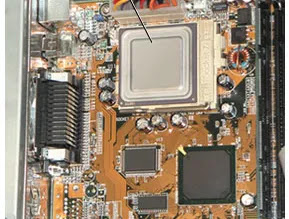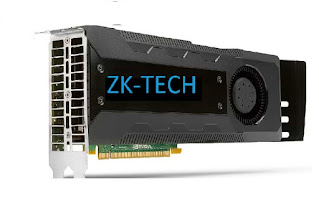What is a GPU (Graphics Processing Unit)? Definition and Examples
 |
| What is GPU? RGB GPU |
What is a GPU (Graphics Processing Unit)?
A graphic processing unit (GPU) is just a computer processor that performs quick mathematical computations to produce visuals and pictures. GPUs are employed in both professional and consumer computer environments. GPUs have traditionally been responsible for the processing of 2D and 3D graphics, animations, and video; however, they now have a broader variety of applications.
These computations were once done by the central processor unit (CPU) in the earliest days of computers. However, when more graphics-intensive apps were created, their demands placed a load on the CPU and reduced performance. GPUs were created to offload various operations from CPUs and also to boost 3D graphics rendering. GPUs operate using a mechanism known as "parallel processing," in which numerous processors handle different aspects of the same operation.
GPUs are well-known in PC (desktop computer) gaming for their ability to generate visuals in a seamless, high-quality manner. GPUs were also used by developers to speed workloads in fields like artificial intelligence (AI).
What Does A Graphic Processing Unit (GPU) Do?
The graphic processing unit, or GPU, has emerged as one of the most essential forms of computing technology for both consumer and corporate use. The GPU, which is intended for parallel computing, is used in a variety of applications, including graphics and video rendering. Although they are most known for their gaming capabilities, GPUs are increasingly being used in creative creations like artificial intelligence (AI).
 |
| What is GPU? RGB GPU / Graphic Card |
GPUs were initially meant to speed 3D graphics rendering. They grew more adaptable and programmable throughout time, expanding their capabilities. With enhanced lighting and shadowing techniques, graphics programmers were able to generate more fascinating visual effects or realistic scenes. Other developers have begun to take advantage of GPUs' ability to drastically speed extra tasks in parallel computing (HPC), learning techniques, and other areas.
How a graphic processing unit (GPU) works
GPUs can be situated on the same electrical circuit as a CPU, on a graphics card, or on the motherboard of a server or personal computer. GPUs as well as CPUs are built in a similar manner. GPUs, on the other hand, are particularly built to execute more complicated mathematical and geometric computations. These computations are required in order to render visuals. GPUs can have more transistors than CPUs.
GPUs will employ "parallel computing," in which numerous processors handle different aspects of the same operation. A GPU will also contain all its RAM (random access memory), which can store information about the pictures it processes. Each pixel's information, including its position on the display, is saved. A digital-to-analogue inverter topology (DAC) is attached to the RAM, and it will transform the picture into an analogue signal for display on the monitor. Video RAM often runs at high rates.
GPUs will be available in two flavors: integrated and discrete. Integrated GPUs are built into the GPU, whereas discrete GPUs are located on a separate circuit.
Companies that need a lot of computational power, deal with machine learning, or do 3D visualizations may benefit from having GPUs in the cloud. Google Cloud GPUs, which provide high-performance GPUs on Google Cloud, are an example of this. The benefits of hosting GPUs in the cloud include freeing up local resources, saving time and money, and increasing scalability. Users may select from a variety of GPU types while receiving variable performance based on their requirements.
Graphic processing unit (GPU) and CPU (central processing unit): Working Together
The GPU emerged as an adjunct to its near relative, the CPU (centralprocessing unit). CPUs have continued to improve performance through architectural advancements, higher clock rates, and the addition of more cores, whereas GPUs are especially built to accelerate computer animation operations. When looking for a system, knowing the function of the CPU vs. GPU may help you get the most out of both.
History of the GPU
Nvidia released the GPU 256, the very first widely available GPU, in 1999. A GPU, according to Nvidia, is a "single-chip processor having integrated transform, lights, triangle configuration, and rendering engines capable of processing at least 10 million polygons every second." The GeForce 256 builds on previous processing technologies by enhancing 3D gaming performance.
While Nvidia continues to dominate the GPU industry, technology has advanced significantly. Nvidia developed the GeForce 8800 GTX in the 2000s, which had a pattern rate of 36.8 billion per second.
GPUs are gaining popularity again today. Because of the introduction of artificial intelligence and crypto currency, its application has expanded into new industries. GPUs have also helped to provide access to more advanced virtual reality games.
Why do you need a GPU?
A decent GPU (in the form of a high-end graphics card) is now an indelible aspect of the immersive gaming or multimedia viewing experience in the consumer market. Mining for crypto currencies has also increased demand for GPUs.
 |
| What is GPU? RGB GPU / Graphic Card |
The potential for GPUs implemented in servers to assist with computational operations is limitless. GPUs thrive in a variety of applications, including machine learning, computer vision, and deep learning. More and more industry players are delivering full solutions that integrate hardware and software to assist customers in many vertical areas reaping the benefits of GPUs, such as industrial, transportation, healthcare, education, and entertainment.
GPUs and Crypto currency Mining
While GPUs were first popular among video editing and computer gaming aficionados, crypto currency’s quick rise generated a new industry. This is because bit coin mining needs millions of calculations to add transactions to a block chain, which might be profitable if you have access to a GPU and a cheap supply of power.
Nvidia Corp. (NVDA) and Advanced Micro Devices Inc. (AMD), two notable graphics card makers, have seen a tremendous surge in sales and income as a result of crypto currency mining in recent years.
This had the unintended consequence of irritating non-mining clients, who saw prices rise and supply dry up. As a result, shops periodically restricted the amount of graphics cards that a customer may buy. While miners of more prominent crypto currencies, such as Bitcoin, have migrated to specialized and less expensive chipsets known as application-specific integrated circuits (ASICs), graphics processing units (GPUs) are still used to mine lesser-known currencies.
What Are GPUs Used For?
GPUs were predominantly employed two decades ago to speed real-time 3D graphics applications like computer gaming. As the twenty-first century began, however, computer scientists understood that GPUs had the ability to tackle some of the world's most complex computing challenges.
This understanding ushered in the age of general-purpose GPUs. Graphics technology is now being used to solve a broader range of challenges. Today's GPUs are more programmable than ever before, allowing them to accelerate a wide range of applications beyond standard graphics rendering.
GPUs for gaming
With hyperrealistic visuals and enormous, sophisticated in-game environments, video games have become more computationally taxing. With enhanced display technologies like 4K panels and high refresh rates, as well as the emergence of virtual reality games, graphics processing needs are increasing rapidly. GPUs can produce visuals in both 2D and 3D modes. Games may be played at larger resolutions, at quicker frame rates, or both with improved visual performance.
GPU for machine learning
AI and machine learning are two of the most interesting uses for GPU technology. Because GPUs have a tremendous amount of processing capacity, they may provide great acceleration for workloads that benefit from GPUs' highly parallel nature, such as image recognition. Many of today's deep learning solutions rely on GPUs collaborating with CPUs.
GPUs for video editing and content creation
Long rendering times have plagued video editors, graphic designers, and other creative professions for years, tying up computational resources and stifling creative flow. Now, the parallel processing provided by GPUs allows rendering video and graphics in higher-definition formats faster and easier.
Intel offers no-compromise options in terms of performance for both the CPU and GPU. Gamers and multimedia makers may now gain even higher performance and additional features with Intel® Iris® Xe graphics. Intel® Iris® Xe graphics are integrated with the CPU and are optimized for 11th Gen Intel® Core TM processors. They are ideal for ultra-thin and light notebooks. Intel® Iris® XeMAX, Intel's first discrete graphics solution in 20 years, is also available in certain laptops.
Intel® Iris® Xe MAX was created to deliver high graphics performance but also media capabilities as well as smooth, immersive 1080p gaming everywhere. all while using a stylish, lightweight laptop. Furthermore, when 11th Gen Intel® CoreTM CPUs, Iris® Xe MAX discrete graphics, and Intel® Deep Link Technology are combined, you may get 1.4 X AI1 performances and 2X higher performance encoding single stream videos2 compared with third-party discrete graphics.
Graphics processing unit (GPU) vs. CPU (Central Processing Unit)
GPU designs are quite similar to CPU architectures. CPUs, on the other hand, are used to respond to and process the basic instructions that power a computer, but GPUs are particularly built to swiftly produce high-resolution graphics and video. CPUs are in charge of understanding the majority of a computer's operations, whereas GPUs are in charge of graphics rendering.
A GPU is often built for data parallelism and applying the same command to numerous data elements (SIMD). A CPU is built for task parallelism and performing various processes.
 |
| CPU |
Both are distinguished by the number of cores. The core is the processor within the processor. The majority of CPU cores are numbered four to eight, while some have up to 32 cores. Each core may handle its own work, known as threads. Because certain processors support multithreading (in which the core is virtually divided, enabling a single core to handle two threads), the number of threads can be significantly higher than the number of cores. This can help with video editing and transcription. CPUs are capable of running two threads (separate instructions) per core (the independent processor unit). Each GPU core can contain four to ten threads.
Because of its parallel-processing design, which allows it to conduct several computations at the same time, a GPU can generate pictures faster than a CPU. A single CPU lacks this capacity, whereas multiprocessor computers may do computations in parallel by merging many CPUs on the same chip.
A CPU also has a quicker clock speed, which means it can complete individual calculations faster than a GPU, making it frequently better suited to fundamental computational tasks.
Graphics Processing Units (GPU) in the Data Center
Intel® Xeon® CPUs with integrated graphics enable spectacular visual experiences in the data centre.
With the Intel® Server GPU, Intel also provides a discrete alternative. Based on Intel® Xe Architecture, this general-purpose GPU is designed to expand exponentially to give a high-density, minimal experience within mobile cloud games and media streaming, including video transcoding.
GPU vs. Graphics Card: What’s the Difference?
While the phrases "graphics card" and "video card" are sometimes used interchangeably, there is a small difference between the two. A graphics card is an add-in board that integrates the GPU, just like a motherboard does. This board also contains all of the components needed to allow the GPU to work and connect to the rest of the system.
GPUs are classified into two types: integrated and discrete. An integrated GPU is incorporated with the CPU rather than on its own separate card. A discrete GPU is a separate chip installed on its own circuit board and often connected to a PCI Express slot.
Discrete Graphics Processing Unit
Many computing applications benefit from integrated GPUs. However, for more resource-intensive applications with high performance requirements, a discrete GPU (also known as a "dedicated graphics card") is better suited.
These GPUs increase processing capacity at the expense of increased energy consumption and heat generation. For best performance, discrete GPUs often require separate cooling.
Integrated Graphics Processing Unit
The vast majority of GPUs on the market have integrated graphics. So, what exactly are integrated graphics and how do they function in your computer? A CPU with a completely integrated GPU on its motherboard enables slimmer and lighter computers, lower power consumption, and lower overall system costs.
 |
| What is GPU? RGB GPU / Graphic Card |
Intel® Graphics Technology is at the forefront of integrated graphics technology, including Intel® ArcTM and Intel® Iris® Xe graphics. Users may enjoy vivid visuals on devices that run cooler and have a longer battery life thanks to Intel® Graphics.
The top GPUs and graphics cards in the market
The GPU market is dominated by Nvidia, Advanced Micro Devices (AMD), Intel, and Arm.
Some of the top GPUs and graphics cards in 2020 were:
When shopping for a graphics card, consider the price, overall value, performance, features, quantity of video RAM, and availability. Support for 4K resolution, 60 frames per second or higher, and ray tracing are all features that customers may be interested in. Price can be a decisive issue in some cases, since some GPUs might cost twice as much for just 10%–15% better performance.
Graphics Processing Unit (GPU) FAQs
What exactly is a GPU in a computer?
Your device's graphics processing unit (GPU) handles graphics-related tasks such as graphics, effects, and movies. Learn about the many types of GPUs and select the one that best suits your needs. Integrated GPUs are incorporated onto the motherboard of your PC, allowing laptops to be small, light, and power-efficient.
Is it preferable to have a GPU or a CPU?
CPUs excel in numerous applications, including high-definition, 3D, and non-image-based deep learning on language, text, and time-series data. For complicated models or deep learning applications, CPUs may handle significantly bigger memory capacities than even the finest GPUs today.
What is the difference between a GPU and a graphics card?
The GPU is the primary chip of a graphics card. A graphics card is a completely working piece of hardware (including the GPU) that includes a PCB, VRAM, and other supporting hardware. A video card is a piece of specialised hardware that speeds up video-related tasks.
Is a GPU suitable for gaming?
Simply put, if you're putting together a gaming PC, the GPU will be your most significant buy. Other components, such as the CPU, storage, and RAM, can also have an effect on performance, but the GPU has the most direct link to what you see on screen when playing.
How much GPU do I require?
According to Nvidia and Adobe, you'll need at least 4GB for light work, and finding a current-generation or older GPU with 4GB shouldn't be too difficult.
Is the GPU more crucial than the CPU?
When it comes to playing certain sorts of games, the GPU is a very vital component of a gaming system, and in many situations, it is even more significant than the CPU. Simple explanation: A GPU is a single-chip processor that is primarily used to control and improve video and graphics performance.
Do laptops include a GPU?
On laptops, there are two types of GPUs: integrated GPUs and discrete GPUs. Integrated GPUs are graphics processing units that are incorporated into the CPU (Central Processing Unit) and provide rudimentary graphic processing capabilities.
Are PC GPUs superior to laptop GPUs?
Laptop GPUs are inferior for good reason.
While everyone wishes for full RTX 3080/3090-like performance on a laptop, it is not possible. The same desktop silicon cannot function in a laptop without immediately encountering heat limitations that prevent it from performing to its full capability or, worse, destroying it.
Which GPU is suitable for gaming?
NVIDIA GeForce RTX 3080
Nvidia's GeForce RTX 3080 with the now-outdated Nvidia Ampere architecture remains an excellent choice, albeit it has lost some of its sparkle. Depending on current costs, the advice also applies to all RTX 3080 cards, including the RTX 3080 Ti and RTX 3080 12GB.
Is a GPU simply a CPU?
They are both silicon-based microprocessors. Both deal with data. However, CPUs and GPUs have distinct architectures and are designed for distinct purposes. The CPU is well-suited to a wide range of tasks, particularly those requiring low latency or high per-core performance.
How can I test my GPU?
In Windows, you can find out what GPU you have.
Type "Device Manager" into your PC's Start menu and press Enter to open the Control Panel's Device Manager. Click the drop-down arrow next to Display adapters, and your GPU should be listed right there.
How much GPU memory is required for gaming?
In general, 2GB of video RAM is the very basic requirement for 1080p gaming, while 4GB is the bare minimum for high-detail 1080p play in 2022. Graphics memory on cards under $300 (MSRP) currently ranges from 1 GB to 8 GB.
Can games be played without a GPU?
Gaming and dedicated graphics cards go together, but you don't have to have one to enjoy the other. Although gaming with integrated, or onboard, graphics is not as simple as gaming with a high-end graphics card, it is more than possible.
What GPU should I purchase?
The quantity of graphics card memory is critical. For 1080p gaming, choose a card with at least 6GB of RAM, ideally 8GB or more. If you play with all of the settings turned up or instal high-resolution texture packs, you'll need additional RAM. More than 8GB is great if you're gaming at very high resolutions, such as 4K.
How do the CPU and GPU interact?
The collaboration of CPU and GPU inside an application can boost data throughput and concurrent computing. The core software runs on the CPU, but the GPU complements the CPU architecture by allowing repeated computations inside the application to execute simultaneously.
Posted By ZK-TECH
Related Posts:

No comments:
Post a Comment